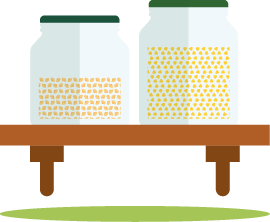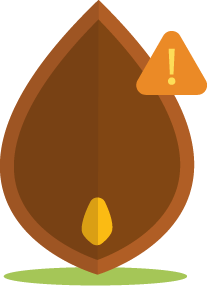
Freekeh is a whole grain cereal with a fluffy, chewy texture and smoky flavour. Freekeh is made by harvesting green durum wheat before the grains are fully ripe. The kernels are then roasted and rubbed, giving them a distinct smoky, nutty flavour. They are usually cracked into smaller pieces, which improves the texture and shortens the cooking time.
Freekeh is mostly found in Middle Eastern and North African cuisine. You can use Freekeh in grain salads, sides, and pilafs.

Freekeh contains many essential vitamins and minerals, including fibre, phosphorus, niacin (vitamin B3), magnesium, copper, zinc, and vitamin B6.
Freekeh contains gluten.

Toggle with the tables below to compare their nutritional content per 100 g (both cooked and uncooked) and per average portion size. You might be surprised by the differences!
| Grains | Kcal | Protein | Fat | Saturated fat | Carbohydrates | Fibre |
|---|---|---|---|---|---|---|
| Freekeh, Per 100 g, uncooked | 356 | 13 | 2 | 76 | 15 |
Whole grains are all packed with carbohydrates and dietary fibre (which is a type of carbohydrate) and are naturally low in (saturated) fat. Fibre is important for our health and the prevention of many chronic diseases. That’s why the European Food Safety Authority (EFSA) recommends we eat at least 25 g of fibre per day. Sometimes, you might see whole grains labelled as ‘high in fibre’ or ‘source of fibre’ – but what does that really mean?
| Grains (% of DRV) | Calcium | Magnesium | Phosphorus | Potassium | Iron | Zinc | Copper | Vit. B1 | Vit. B2 | Vit. B3 | Vit. B6 | Folate |
|---|---|---|---|---|---|---|---|---|---|---|---|---|
| Freekeh, per 100 g, uncooked | 47.50 | 181 | 412 | 410 | 0.49 | 1.80 | 0.19 | 1.30 |
% of DRV stands for dietary reference value. DRV stands for dietary reference value. These values estimate how much of a nutrient most healthy people in Europe need each day. Ideally, we should aim to reach 100% of these values daily. Each vitamin and mineral has their own DRV, as set by EFSA.
You might have heard that whole grains are ‘high in,’ ‘rich in,’ or ‘source of’ a certain vitamin or mineral. These term are regulated by EFSA and products must meet specific rules to be considered as such. Here’s how to interpret these contributions:

Store in an airtight container in a cool, dry place. Follow the instructions on the packaging to keep the food good for as long as possible.
Freekeh has a best-before date, meaning that it can often be eaten after that date has passed. If it looks, smell and tastes good, and the packaging is also intact, it will most likely be safe.

Follow the instructions on the packaging to cook freekeh.
As a general rule of thumb, use a ratio of 1 part of freekeh to 2 ½ parts of water. Bring to boil, then simmer 20-25 minutes until tender. Drain any excess liquid off.

When you see freekeh or cracked freekeh on an ingredient list you can almost always be sure it is whole freekeh, and is a whole grain.
Learn to identify whole grain products, cook delicious meals, find practical tips for a smooth, gradual switch, and much more!